Netflix’s Somos Sheds Dim Light on Dark Chapter of Mexican History

Something absolutely terrifying happened in 2011 in the small town of Allende in Northern Mexico. A village community of only about 23,000, located about 40 minutes from Texas by car, is now a ghost town a decade later because of the massacre that unfolded there in March 2011. Soldiers of the violent Zetas cartel flooded into the city and simply destroyed it. They murdered dozens of people (possibly hundreds) and razed their homes and businesses in retaliation for what could have been the end of their criminal organization. And the U.S. government played a role. A fuse was lit when a DEA agent convinced a Zetas soldier to hand over cell numbers of two of the major players in the organization, but the DEA then shared that intel with the Mexican federal police, a major error given the corruption in that part of the world, which allowed the leak to get back to the power players, leading to carnage.
For his first venture into television, Oscar-nominated writer James Schamus (for “Crouching Tiger, Hidden Dragon“) has dramatized this story, telling a tale of fictional characters in the final days of Allende. There’s clearly enough narrative here for a six-episode drama but Schamus, writer Monika Revilla, and directors Álvaro Curiel and Mariana Chenillo struggle with tone, often feeling like they’re not humanizing the people who died in Allende, but turning them into two-dimensional TV characters. Without the necessary depth, the people of Allende in “Somos” are like ghosts, and the whole project lacks anything other than tragedy to real hold onto.
“Somos” opens in March 2011 as low-level cartel members grab weapons to take into Allende and unleash hell. After a few scenes of the massacre, it jumps back, filling in the stories of the people who live in this tight-knit community (as writer Ginger Thompson notes in her ProPublica piece on which the film is based, it was a particularly startling series of murders given that the cartel leaders lived in the village with these people). We see the face of a young man named Paquito in those first scenes, being handed a machete, and so his seemingly normal life three months earlier comes branded with poignancy. “Somos” draws connections through the community from the young man to a hot dog vendor to a firefighter to a local vet and so on and so on. Sadly, he often fails to make these people feel distinct and memorable as he does so. Stories of sex workers, abortion, drug violence, and economic depression verge on what some critics call “poverty porn,” highlighting the darkness that existed in Allende before the violence in a way that might be genuine but verges on exploitative. Look at these truly sad people who you know are going to die. Isn’t it sad? The worst parts of “Somos” linger in the sadness—shots of people looking forlornly off into the Mexican horizon, almost as if they know they won’t make it to the end of the year.

“Somos” is at its best when it’s casual and realistic, capturing how normalcy was upended by violence. A subplot involving a budding romance between two young soccer players, including the only woman on the school team, is charming and delightful. Both performers have a natural, lived-in sensibility that the show often lacks in its showier moments, particularly the fantastic Jimena Pagaza. But the honesty one finds in those scenes and a few others (especially ones involving a ranch owner beset upon by the cartel long before March) is too often off-set by passages that seem forced and scripted. The moments with the DEA are particularly wooden both in dialogue and performance, almost in a way that reads as intentional. They wallow in so many clichés of tough DEA dialogue that they’re a minor rewrite away from parody, leading one to question if the storytellers set out to make them exaggerated, a world away from the people of Allende.
There are times when “Somos” looks remarkable, and the craft is always strong, but I was struck too often by how little investment I had in the show. As it returns to the tragedy in the feature-length final episode, I wanted to care more about what was happening, and it wasn’t until I returned to Thompson’s excellent aforementioned piece that I really understood the depth of what happened in Allende. I wish the show could have done more of that instead.
Whole season screened for review.





